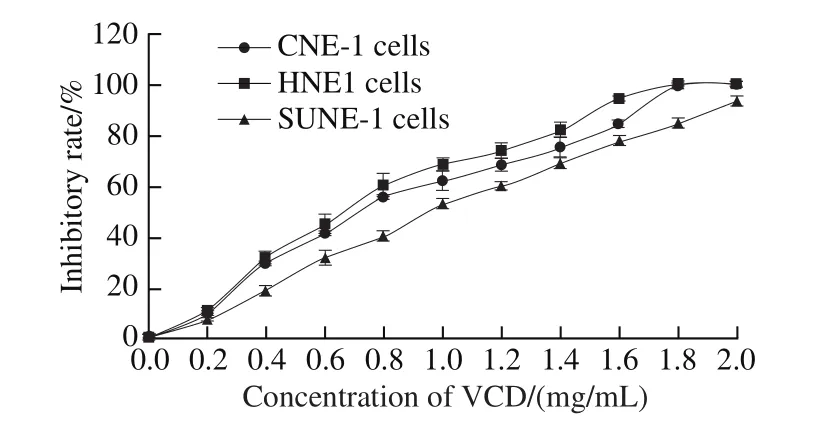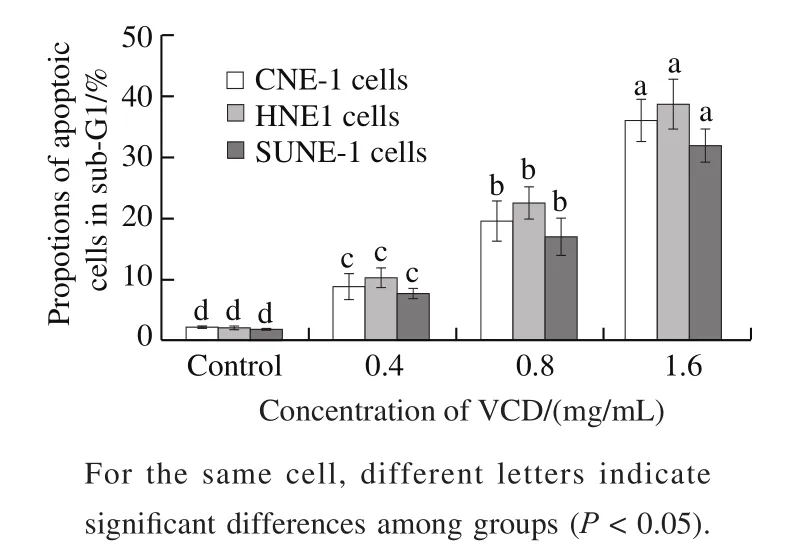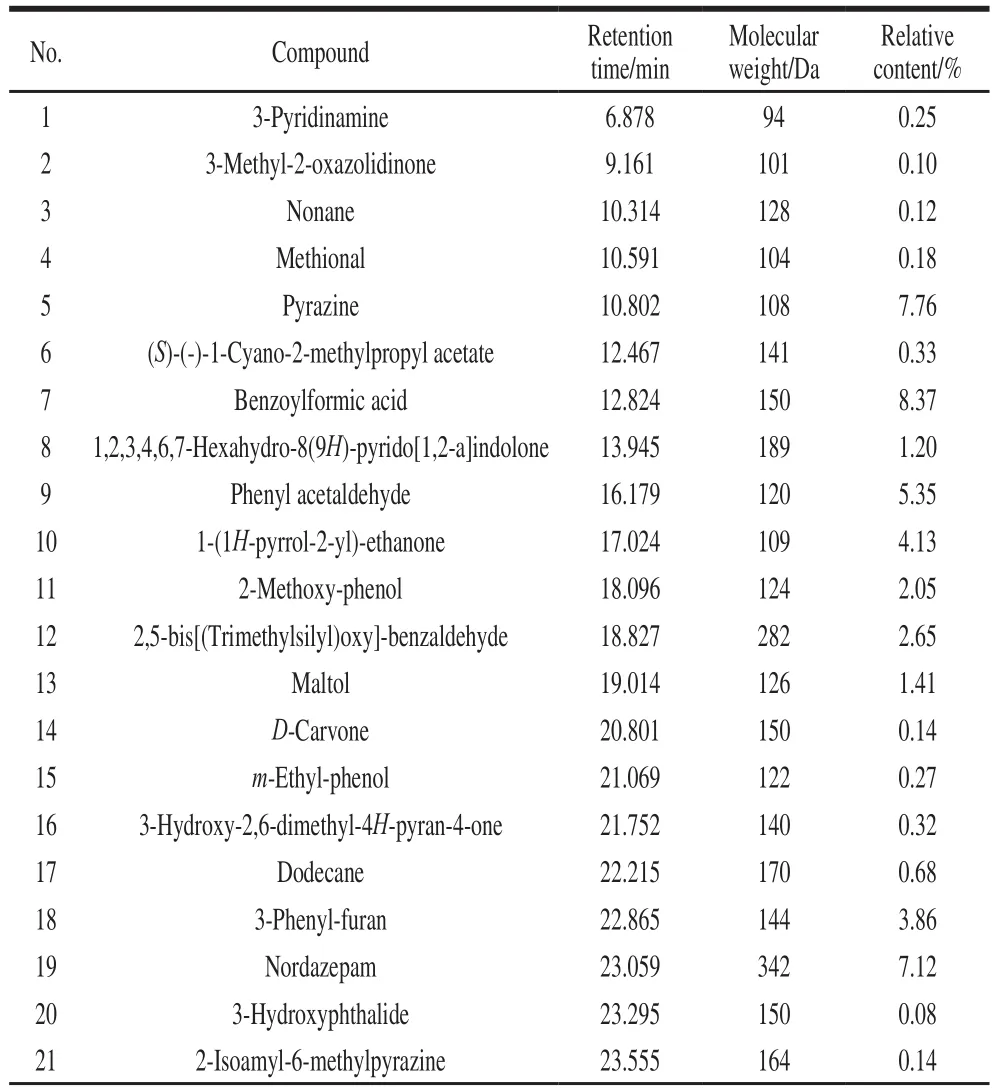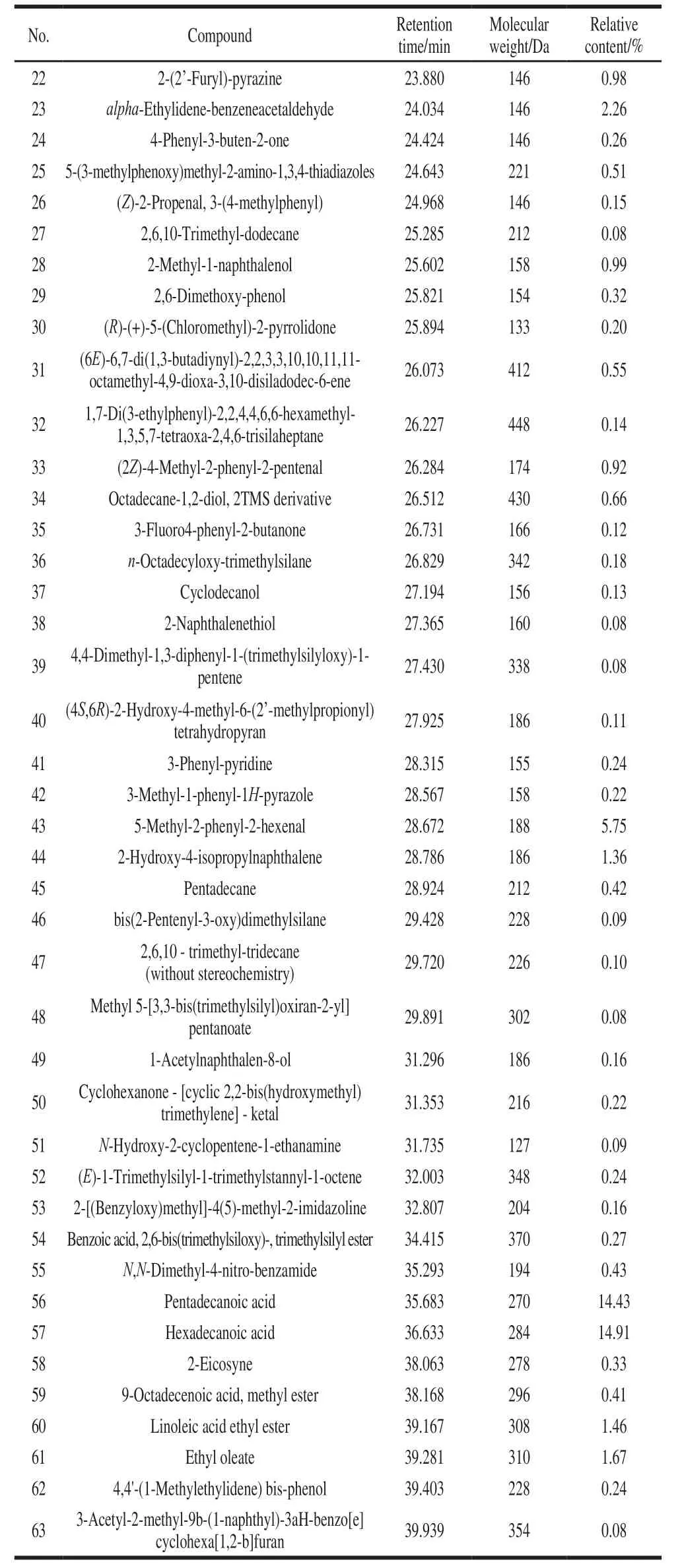Apoptosis-Inducing Effect and Underlying Mechanism of Aroma Components from Douchi on Human Nasopharyngeal Carcinoma CNE-1 Cells
LI Guijie, ZHANG Jing, SUN Peng, QIAN Yu, ZHAO Xin,*
(1. Chongqing Collaborative Innovation Center for Functional Food, Chongqing Engineering Research Center of Functional Food,Chongqing Engineering Laboratory for Research and Development of Functional Food, School of Biological and Chemical Engineering,Chongqing University of Education, Chongqing 400067, China; 2. Environmental and Quality Inspection College,Chongqing Chemical Industry Vocational College, Chongqing 401228, China)
Abstract: Douchi is a traditional fermented soybean food with many beneficial health effects. The aim of this study was to determine the in vitro apoptosis-inducing effect of the volatile components of Douchi (VCD) and to examine the relationship between anticancer effects and VCD. After treatment with 0.4, 0.8, and 1.6 mg/mL VCD for 48 h, the proliferation of human nasopharyngeal carcinoma CNE-1 cells was inhibited, and treatment with 1.6 mg/mL VCD had the highest inhibitory effect(84.6%). Treatment with 0.4 and 0.8 mg/mL VCD also showed good inhibitory effects with the apoptosis rates of 29.7%and 55.6%, respectively. The flow cytometry results showed that 36.2% of the 1.6 mg/mL VCD treated CNE-1 cells in the sub-G1 phase. Reversed transcription-polymerase chain reaction (RT-PCR) analysis indicated that VCD could significantly induce apoptosis in CNE-1 cancer cells (P < 0.05) by upregulating cysteine-aspartic acid protease (caspase)-3, caspase-8,caspase-9, Bax, p53, p21, E2F1, p73 and IκB-α expression and by downregulating Bcl-2, Bcl-xL, human inhibitor of apoptosis protein (HIAP)-1, HIAP-2 and NF-κB mRNA expression in a dose-dependent manner. VCD contained 63 chemical compounds that could potentially cause apoptosis in CNE-1 cells. These results showed that VCD had in vitro apoptosisinducing effects in CNE-1 cells, and this effect was ascribed to the complex chemical composition of VCD.
Keywords: Douchi; aroma components; apoptosis; CNE-1 cells; reversed transcription-polymerase chain reaction
Bcl-2 can inhibit the occurrence of apoptosis though the effects of Bcl-2 on inhibiting the release of glutathione,reducing/countering the redox state of the mitochondrial sulfhydryl group to control its membrane potential. Bcl-2 can also play an indirect role with cystine enzyme , Bcl-2 locates the apoptotic protease activating factor Apaf-1 to the mitochondrial membrane. By regulating its structure,blocking the activation of apoptotic protease, the role of Cty-c can be exerted to prevent cells from dying[1]. Bax protein in non-active monomer distribution in the cytoplasm, only to apoptosis in which the received signal is activated after stimulation, molecular conformational change, transposition and insertion of the outer membrane of the mitochondria to form a large Bax channel, damage the integrity of mitochondrial membrane, and inhibit the apoptosis and Bcl-2 protein play against, inhibit the anti-apoptosis[2]. Bax/Bcl-2 signaling pathway is an important pathway for cancer cell apoptosis. The active component regulates the pathway,which can effectively induce apoptosis of cancer cells.
Douchi (black bean paste) is a traditional salt-fermented soybean product. Selected soybean or black beans are soaked and cooked, then fermented with microbial, adding other seasonings such as salt and wine. In China, Douchi is a type of traditional seasoning for food with many functional components[3]. Meanwhile, Douchi is a type of Chinese soybean functional food, which can treat many diseases such as anemofrigid cold, headache, fever, abdominal pain and food poisoning, as well as helping with digestion[4].
Douchi not only has high nutritional value, it is also a traditional Chinese health food in many previous ancient books throughout the ages[5]. Study on the health care benefits of Douchi through modern research methods by Japanese scientists suggests that Douchi has many health functions such as helping digestion, relieving fatigue, slowing aging and improving the body’s natural disease resistance ability[6].The main physiologically active substances in Douchi are soy isoflavones, brown pigment, thrombolytic enzyme,soybean phospholipid, soybean oligosaccharides, soybean saponins and soybean peptides to name a few[7]. It is shown that functional foods with excellent antioxidant effects can,to some extent, prevent cancer; the effective ingredients in Douchi have good antioxidant effects, so Douchi may have good anti-cancer effects[8-9].
Flavour is one of important qualities of food, which mainly depends on aroma components with fragrance.Because of the diverse microorganisms and one-year fermentation, many aroma components were produced in Douchi[10]. By the high temperature of simple traditional manufacturing method or cooking, the aroma components of Douchi were dissipated and not be further utilized; using some new food processing techniques or cooking methods might keep these aroma components, this processing could increase the flavor of Douchi and also raise its functional effects. Modern processing methods can fully retain all the ingredients in the food, especially the aroma components that are hard to preserve, which can greatly improve the health care function of food. But there are few studies on the functional effect of fermented soya bean, but no study on the functional function of its aroma components. Flavour of aroma components can act directly in the nasal cavity, therefore aroma components may act on nasopharyngeal carcinoma. The aroma components in Douchi were detected in this study to determine their anti-cancer effects, providing scientific support for the functions of making full use of Douchi.
1 Materials and Methods
1.1 Materials and Reagents
The Douchi sample was provided from Yongchuan Douchi Food Co. Ltd. (Chongqing, China).
Human nasopharyngeal carcinoma CNE-1, HNE1 and SUNE-1 cells obtained from the American Type Culture Collection (ATCC, Manassas, USA) were used for this study.
RPMI-1640 medium, fetal bovine serum (FBS),penicillin-streptomycin, 9,12-octadecadienoic acid, ethyl ester, octadecanoic acid, ethyl ester, (+)-α-funebrene,phenylethyl alcohol, hexadecanoic acid, ethyl ester Gibco Co. (USA); DNA staining kit Becton, Dickinson and Company (USA); TRIzol reagent Thermo Fisher Scientific Inc. (USA).
1.2 Instruments and Equipments
Forma CO2incubator, SimpliAmp thermal cycler Thermo Scientific Inc. (USA); EPICS XL-MCL flow cytometer Beckman Instruments Inc. (USA); 5975C gas chromatography-mass spectrometer (GC-MS) Agilent Technologies Inc. (USA).
1.3 Methods
1.3.1 Preparations of aroma components of Douchi
Douchi sample were treated by ultra-high temperature instantaneous sterilization (135 ℃ for 4 s), then 5 g of Douchi sample were extracted through solid-phase microextraction(SPME), ground, and went through 40 mesh. The sample was put in a 15 mL SPME sample bottle and sealed with a lid. SPME needle pre-purified with high temperature was inserted, and the fiber head was exposed to the top of the sample bottle and extracted in 60 ℃ water bath for 20 min.Then the fiber head was put into 15 mL distilled water for extraction, this extraction was repeated for 10 times and combined. The 10 times extraction was frozen and dried and used for cell based experiments.
1.3.2 Cancer cell preparation
RPMI-1640 medium was supplemented with 10%FBS and 1% penicillin-streptomycin. The CNE-1, HNE1 and SUNE-1 cancer cells were cultured in the RPMI-1640 medium at 37 ℃ in a humidified atmosphere containing 5%CO2. The medium was changed three times per week.
1.3.3 Groups and processing
Each cell was divided into four groups: control group and 0.4, 0.8, 1.6 mg/mL VCD treated group. In the control group, the cancer cells were not treated with VCD, and the cancer cells of VCD treated groups were treated at concentrations of 0.4, 0.8 and 1.6 mg/mL VCD, respectively.
1.3.4 Growth inhibitory rate measurement
The growth inhibitory effects of VCD in CNE-1,HNE1 and SUNE-1 cancer cells were determined by the 3-(4,5-dimethylthiazol-2-yl)-2,5-diphenyltetrazolium bromide (MTT) assay[4]. Human nasopharyngeal carcinoma CNE-1, HNE1 and SUNE-1 cells were cultured at a density of 1 × 104cells/well in a volume of 100 μL in 96 well plates.CNE-1, HNE1 and SUNE-1 cells adhered after 24 h and were cultured in different concentrations of VCD (0.4, 0.8 and 1.6 mg/mL) for 48 h. Culture medium was discarded and changed to 100 μL MTT solution (0.5 mg/mL) and cultured for an additional 4 h. Supernatants were discarded and 100 μL dimethyl sulphoxide were added and incubated with agitation for 30 min without light. The OD values were measured at 540 nm and the cell survival rate was calculated by the formula.

1.3.5 Flow cytometry analysis
CNE-1 cells were treated with 0.4, 0.8 and 1.6 mg/mL of VCD under the same conditions of the growth inhibitory test. After treated with trypsinization, collection, and washing by cold phosphate buffered saline, CNE-1, HNE1 and SUNE-1 cells treated with the VCD were determined using the DNA staining kit. Fluorescence intensity was determined using a flow cytometer[4].
1.3.6 mRNA expression measurement
The expression levels of capase-3, capase-8 and capase-9 in CNE-1 cells were checked using reverse transcription-polymerase chain reaction (RT-PCR) after 48 h incubation with 0.4, 0.8 and 1.6 mg/mL VCD. CNE-1 cells were cultured in 10 cm cell culture platesin the same conditions as the growth inhibition measurement assays. After treatment with VCD and chemical standard of 9,12-octadecadienoic acid,ethyl ester, octadecanoic acid, ethyl ester, (+)-α-funebrene,phenylethyl alcohol, hexadecanoic acid, ethyl ester, total RNA from CNE-1 cells was isolated using Trizol reagent according to the manufacturer’s recommendations. The concentrations of total RNA from each sample group were adjusted to be the same. Equal amounts of RNA(2 μg) were added with 1 μL Oligo(dT)18, RNase, dNTP and MLV, 5 × buffer 10 μL, in a total volume of 20 μL.Conditions to synthesize cDNA were 37 ℃ 120 min, 99 ℃4 min, and 4 ℃ 3 min. After gene reverse transcription,polymerase chain reaction was performed. Caspase-3(forward: 5’-CAAACTTTTTCAGAGGGGATCG-3’;reverse: 5’-GCATACTGTTTCAGCATGGCA-3’),caspase-8 (forward: 5’-CCCCACCCTCACTTTGCT-3’;reverse: 5’-GGAGGACCAGGCTCACTTA-3’), caspase-9(forward: 5’-GGCCCTTCCTCGCTTCATCTC-3’; reverse:5’-GGTCCTTGGGCCTTCCTGGTAT-3’), Bax (forward:5’-AAGCTGAGCGAGTGTCTCCGGCG-3’; reverse:5’-CAGATGCCGGTTCAGGTACTCAGTC-3’), Bcl-2(forward: 5’-CTCGTCGCTACCGTCGTGACTTGG-3’;reverse: 5’-CAGATGCCGGTTCAGGTACTCAGTC-3’),Bcl-xL (forward: 5’-CCCAGAAAGGATACAGCTGG-3’;reverse: 5’-GCGATCCGACTCACCAATAC-3’), HIAP-1(forward: 5’-GCCTGATGCTGGATAACTGG-3’; reverse:5’-GGCGACAGAAAAGTCAATGG-3’), HIAP-2(forward: 5’-GCCTGATGCTGGATAACTGG-3’; reverse:5’-GCTCTTGCCAATTCTGATGG-3’), p53 (forward: 5’-CT GAGGTTGGCTCTGACTGTACCACCATCC-3’; reverse:5’-CTCATTCAGCTCTCGGAACATCTCGAAGCG-3’),p21 (forward: 5’-GCAGACCAGCATGACAGATTT-3’;reverse: 5’-GGATTAGGGCTTCCTCTTGGA-3’), E2F1(forward: 5’-GGGGAGAAGTCACGCTATGA-3’;reverse: 5’-CTCAGGGCACAGGAAAACAT-3’), p73(forward: 5’-GACGGAATTCACCACCATCCT-3’;reverse: 5’-CCAGGCTCTCTTTCAGCTTCA-3’),NF-κB (forward: 5’-CACTTATGGACAACTATG AGGTCTCTGG-3’; reverse: 5’-TCTTGTGGACA ACGCAGTGGAATTTTAGG-3’), IκB-α (forward:5’-GCTGAAGAAGGAGCGGCTACT-3’; reverse:5’-TCGTACTCCTCGTCTTTCATGGA-3’) and GAPDH(forward: 5’-CGGAGTCAACGGATTTGGTC-3’; reverse:5’-AGCCTTCTCCATGGTCGTGA-3’) sequences were targeted according to the above treatment. Reaction condition was denature for 5 min at 95 ℃, anneal for 50 s at 58 ℃,ligate for 90 s at 72 ℃, cycle for 40 times, ligate for 10 min at 72 ℃. The expression of end product was tested with 2% (m/m) agarose gel electrophoresis and quantitatively analyzed through ImageJ software[4].
1.3.7 Component analysis of aroma components of Douchi
5 g of Douchi sample were extracted through SPME,ground, and went through 40 mesh. The sample was put in a 15 mL SPME sample bottle and sealed with a lid. SPME needle pre-purified with high temperature was inserted,and the fiber head was exposed to the top of the sample bottle and extracted in 60 ℃ water bath for 20 min and then inserted into the GC-MS sample injector for analysis. GCMS chromatogram of the aroma components was analyzed by computer and artificial identification, and each peak was compared and matched with that in two compound-searching libraries-NIST library and WILEY library. The results were determined positive if the similarity index (SI) > 800 (the maximum is 1 000). The relative content of compounds was determined by the area normalization method[11].
1.4 Statistical analysis
Experimental data are presented as the. Differences between the mean values for individual groups were assessed with a One-way ANOVA with Duncan’s multiple range test.Differences were considered significant when P < 0.05. SAS version 9.2 (SAS Institute Inc., Cary, NC, USA) was used for statistical analyses.
2 Results and Analysis
2.1 Growth inhibitory and apoptotic effects of VCD against CNE-1, HNE1 and SUNE-1 cells
As shown in Fig. 1. At the concentration of 1.8 mg/mL VCD, the growth inhibitory rate of three cancer cells all were greater than 80%. From the concentration 0 to 1.8 mg/mL,the inhibitory effects raises were dose-dependent. At the concentration of 0.4, 0.8 and 1.6 mg/mL of VCD, the inhibitory rates were 29.7%, 55.6% and 84.6% in CNE-1 cells, respectively. These inhibitory rates in HNE1 and SUNE-1 cancer cells were 32.1%, 60.3%, 94.2% and 19.3%,40.1%, 77.3%, respectively. Based on these results, at the concentration of 0-1.6 mg/mL, VCD showed a significant positive correlation with the function of cancer cells, the concentration of 0.4, 0.8 and 1.6 mg/mL of VCD were chosen for other cell based experiments.

Fig.1 Growth inhibitory effects of VCD on human nasopharyngeal carcinoma CNE-1, HNE1 and SUNE-1 cells
2.2 Apoptotic effects of VCD against CNE-1, HNE1 and SUNE-1 cells
After being treated with VCD, the sub-G1 DNA proportions of CNE-1, HNE1 and SUNE-1 cancer cells were evaluated by flow cytometric analysis. The induction of apoptosis was 2.1%, 2.2% and 1.8% of sub-G1 proportion in control CNE-1, HNE1 and SUNE-1 cells (VCD untreated).However, 1.6 mg/mL VCD treated CNE-1, HNE1 and SUNE-1 cells showed the highest proportions of sub-G1, which were 36.2%, 38.8% and 32.1%, respectively. Compared to the control group, 0.4 and 0.8 mg/mL VCD treatment also could increase the proportion of apoptoic cells in sub-G1, which were at 8.9% and 19.7% in CNE-1 cells, 10.3% and 22.6% in HNE1 cells, 7.7% and 17.1% in SUNE-1 cells, respectively (Fig. 2).VCD showed similar effects by flow cytometric analysis in the three cancer cells, VCD had the good inhibitory effects on the three oral cancer cells. CNE-1 cells were used more widely in the experimental studies, so this study also chose this cell line for follow-up experiments.

Fig.2 Apoptosis-inducing effects of VCD on human nasopharyngeal carcinoma CNE-1, HNE1 and SUNE-1 cells
2.3 Gene expression in CNE-1 cells after treatment with VCD

Fig.3 Effects of VCD on mRNA expression in human nasopharyngeal carcinoma CNE-1 cells
The expression of caspase-3, caspase-8, caspase-9, Bax,p53, p21, E2F1, p73 and IκB-α in CNE-1 cells after VCD treatment were significantly (P < 0.05) changed compared to the VCD untreated cells (Fig. 3). And these expressions were increased by VCD in a dose-dependent manner. Meanwhile the mRNA expression of Bcl-2, Bcl-xL, HIAP-1, HIAP-2 and NF-κB decreased with VCD treatment in CNE-1 cells compared to the control cells.
2.4 Chemical constituents of VCD in cells after treatment with VCD
The 63 compounds were found in VCD by GC-MS assay (Table 1). There were 7 compounds present at more than 5% of the total content. They were pyrazine (7.76%),benzoylformic acid (8.37%), phenyl acetaldehyde (5.35%),nordazepam (7.12%), 5-methyl-2-phenyl-2-hexenal(5.75%), pentadecanoic acid (14.43%) and hexadecanoic acid (14.91%). These 7 substances accounted for 52.59%of the VCD content, so the 7 substances above were mainly analyzed. There were few study showed that the two substances of phenyl acetaldehyde and 5-methyl-2-phenyl-2-hexenalh had strong biological activities, therefore the other 5 compounds might be major bioactive components in VCD. It could be seen that the relative content of higher contents of active component in VCD is 52.59%, therefore the 5 compounds were chose for RT-PCR assay in cancer cells. The results could clarify the anticancer effect of aroma components of Douchi in CNE-1 cancer cells.

Table1 Aroma components of Douchi

Continued to Table 1
2.5 Gene expression of NF-κB and IκB-α after CNE-1 cells treated with the aroma components in VCD
VCD contained high contents of pyrazine, benzoylformic acid, nordazepam, pentadecanoic acid and hexadecanoic acid,these component standards were used to treat the cancer cells.Concentration of 1.6 mg/mL of pyrazine, benzoylformic acid,nordazepam, pentadecanoic acid and hexadecanoic acid could increase the mRNA expression of caspase-3, caspase-8,caspase-9, Bax and decrease the expression of Bcl-2, Bcl-xL(Fig. 4). These expressions of nordazepam treated cells were close to the VCD treatment in CNE-1 cells.

Fig.4 Effects of VCD on mRNA expression of caspases and Bcl-2 family in human nasopharyngeal carcinoma CNE-1 cells
3 Discussion
Previous studies have shown that Douchi has anticancer effects in vitro, and most of these anticancer effects depend on its apoptotic properties. This study examined the apoptotic effects of the aroma components of Douchi(VCD) by observing the relationship of their influence on gene expression in CNE-1 cancer cells and the components in VCD. Human nasopharyngeal carcinoma CNE-1, HNE1 and SUNE-1 cells were often used for anticancer effects determination of functional foods. CNE-1 cell line is used as in vitro model to study tumor model for nasopharyngeal carcinoma. Under standard culture conditions, these cells would grow orderly, these standard cells could be used to determine the apoptosis inducing effects well[12-14]. First,CNE-1, HNE1 and SUNE-1 cancer cells were treated by VCD, and the apoptosis inducing effects of VCD were checked by MTT and flow cytometry analysis in this study.The results of these experiments were similar on the whole,CNE-1, as the often using cell line, was chosen for further experiments.
Caspase is a protease hydrolysate which usually exists in the form of pro-caspase. However, caspase-3, -8 and -9 were the main protease hydrolysates involved in the process of apoptosis among these pro-caspases[15]. Caspase-8 and caspase-9 are upstream of the apoptosis pathway, and are responsible for activation of other caspases downstream,while caspase-3 lies downstream and is responsible for the hydrolysis of apoptotic factors. After being actived through different pathways, caspase-8 and caspase-9 activates caspase-3[16]. Both activation of caspase-8 induced by death receptor-mediated apoptotic pathways and activation of caspase-9 induced by mitochondria-mediated apoptotic pathways could trigger downstream caspase cascades.Hydrolysis activates caspase-3 and active caspase induces apoptosis. When caspases trigger apoptosis, proteins such as calpain, cathepsin and endonucleases carry out programmed cell death[17]. By interacting with caspases, these proteins help accelerate apoptosis. VCD could change the expression of caspases in CNE-1 cells thus inducing apoptosis.
Bcl-2 and Bcl-xL are anti-apoptotic genes, while Bax is a pro-apoptotic gene. Bcl-2 prevents the release of cytochrome c from the mitochondria to the cytoplasm, thus inhibiting apoptosis[18]. Bcl-2 is the most important member in the Bcl-2 family of genes and is regarded as an inhibitory element of cancer cell apoptosis. Bax is the main apoptosis factor in the Bcl-2 family genes[19]. After neutralizing and abating Bcl-2 and Bcl-xL, activated Bax releases pro-apoptotic factors to the cytoplasm and induces cancer cell apoptosis[20]. VCD could induce aptoptosis of CNE-1 cancer cells by increasing the Bax mRNA level as well as by decreasing Bcl-2 and Bcl-xL levels.
HIAP-1 and HIAP-2 are caspase inhibitors in cancer cells, and can inhibit apoptosis in cancer cells[21]. With the decrease of the expression of HIAP-1 and HIAP-2, the expression of caspases in cancer cells increased and the apoptotic effects of caspases has been strengthened[22]. Our results showed that VCD could decrease the mRNA levels of HIAP-1 and HIAP-2 and enhance the expression of caspases.
p53 is a tumour suppressor. It is most closely related to colon cancer. p53 is a transcription factor, promoting the expression of Bax and participating in the mitochondria mediated apoptosis pathway[23]. p53 combines with Bcl-xL and releases Bax from the Bax/Bcl-xL compound, and p53 also increases the expressions of pro-apoptotic genes in the cytoplasm in order to activate caspase effecters in the cytoplasm and induce apoptosis. p21 also promotes apoptosis.p21 is closely related to Bax and enhances the expression of Bax[24]. The apoptotic effects of p21 are stronger than Bcl-2.VCD might induce apoptosis in CNE-1 cancer cells by increasing p53 and p21 mRNA expression levels.
E2F1 has especially good effects on inducing apoptosis.High E2F1 expression causes cancer cells to arrest in the DNA synthesis stage of interphase leading to apoptosis.E2F1 also directly promotes the apoptotic effects of p53 by stabilizing it[25]. p73 is a pro-apoptotic factor in cancer cells. The CNE-1 cancer cells induced apoptosis after VCD treatment by increasing E2F1 and p73 expressions.
NF-κB could regulate anti-apoptotic genes of caspase family[26]. Caspases could invoke NF-κB pathway independent of its pro-apoptotic protease activities. Death effector domains containing caspase-8 could also activate the NF-κB pathway[27]. NF-κB is located in the cytosol complexed with the inhibitory IκB-α gene, IκB-α inhibits NF-κB[4]. VCD could reduce NF-κB and raise IκB-α mRNA expression, and these changes might help to induce apoptosis through the caspases way.
During the fermentation process, there were 63 kinds of aroma components with fragrance in Douchi belonging to nine categories, including esters, alkenes, acids, alcohols,ketones, aldehydes, phenols, benzenes, and furans. Ester compounds are being tested as new anti-cancer treatments in many studies, these compounds induced apoptosis in cancer cells[28-29]. Pyrazine is an intermediate for medicine chemosynthesis, its products had many functional effects,such as phenazine, which is an effective anti-cancer substance[30]. Pyrazine compounds also had protective effects on oxidative stress damages vascular endothelial cells[31].Benzoylformic acid also is an intermediate for medicine chemosynthesis, it contains multiple active groups, therefore,it might has some functional effects[32]. Nordazepam is used as a drug for treating anti-anxiety, sedation, muscle relaxation[33],it might play a role in cancer prevention. VCD contains about 7.12% of nordazepam, this compound might be an important anticancer component. Pentadecanoic acid could be used as a biomarker, it is a functional compound for children[34], it also might be used for cancer treatment. Hexadecanoic acid has antioxidant properties, helping treat inflammation caused by oxidative stress[35]. There were studies also showing that hexadecanoic acid has apoptotic effects in osteosarcoma cells and insulinoma cells[36-37].
All of these 63 substances in VCD working together could have a good influence on fighting against nasopharyngeal carcinoma cells in vitro. This study also showed the similar in vitro results, nordazepam showed higher anticancer effects than pyrazine, benzoylformic acid,pentadecanoic acid and hexadecanoic acid in CNE-1 cells by RT-PCR assay, and the effects were only weaker than VCD in this study. Pyrazine, benzoylformic acid, pentadecanoic acid and hexadecanoic acid also had the certain anticancer effects. However, pentadecanoic acid and hexadecanoic acid only had anticancer effects on some genes. The anticancer effects of VCD might be from pyrazine, benzoylformic acid, nordazepam, pentadecanoic acid and hexadecanoic acid.VCD contained 7.12%, 14.43% and 14.91% of nordazepam,pentadecanoic acid and hexadecanoic acid, respectively. They might be the most important components for the anticancer effects of VCD. These components might make the associative action, and the action could cause the anticancer effects of VCD in nasopharyngeal carcinoma.
In summary, the in vitro apoptotic effects of VCD were determined using MTT, flow cytometry, and RT-PCR. The mechanisms of these apoptotic inducing effects were further analyzed by component analysis of VCD using GC-MS.VCD showed good cancer cells inhibitory effects in CNE-1 cancer cells, and also could change apoptosis related gene expression. From these results, the in vitro apoptotic inducing effects of VCD could be confirmed. After the chemical substances analysis, some cancer-resisting substances were found in VCD. By comprehensive analysis, VCD had apoptotic effects in cancer cells by its compounds. Keeping these compounds by the manufacturing method or cooking changes could enhance the qualities of Douchi in flavor maintaining and functional effects enhancement.

